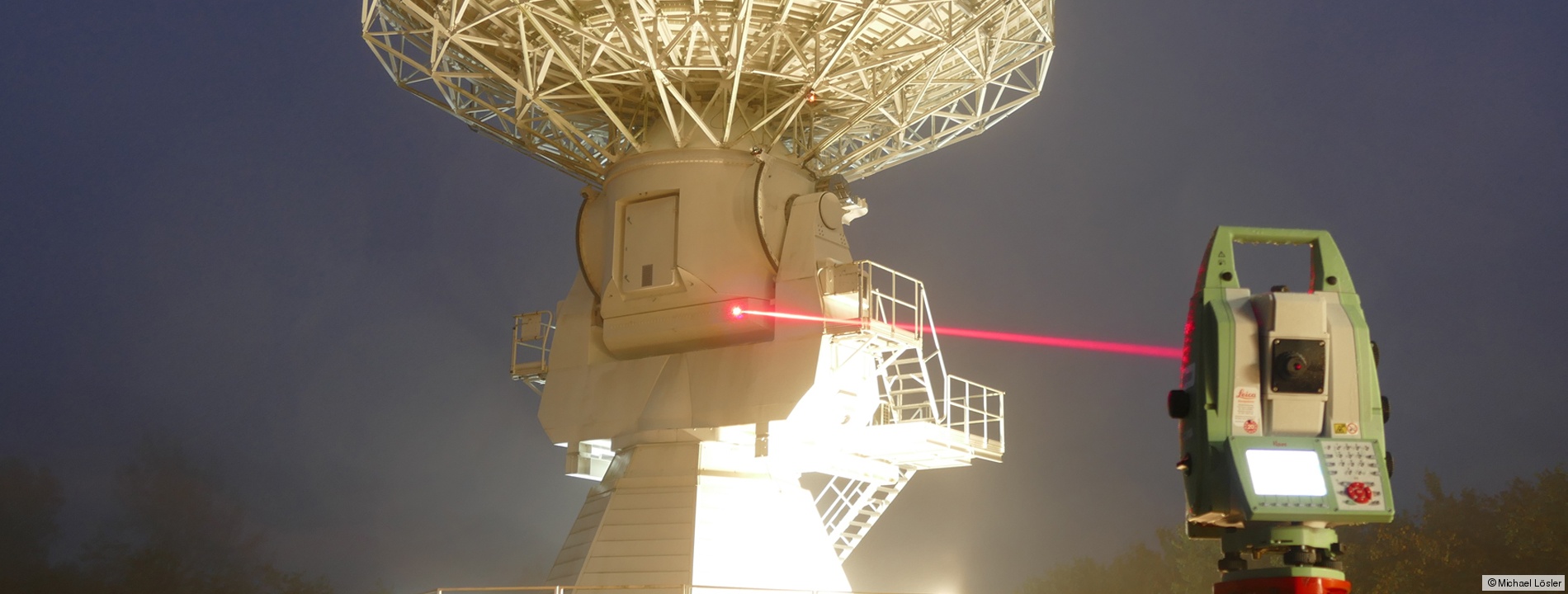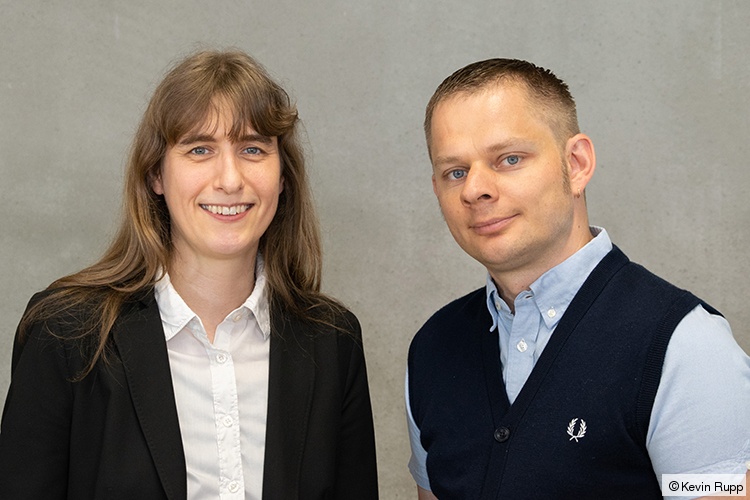Crucial component: local ties
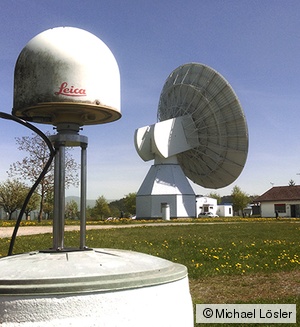
The International Terrestrial Reference Frame (ITRF) as well as Earth orientation parameters (EOP) are derived by observations obtained by several space geodetic techniques such as Very Long Baseline Interferometry (VLBI), Satellite Laser Ranging (SLR), Doppler Orbitography and Radiopositioning Integrated by Satellite (DORIS), or the Global Navigation Satellite System (GNSS). Earth orientation parameters provide only a weak physical connections between the space geodetic techniques. For that reason, EOPs cannot be used exclusively to combine the space geodetic techniques into a reference frame. Additional geometric information is required to obtain a reliable and consistent Earth-fixed reference frame. This geometric information is obtained by precise terrestrial measurements at so-called multi-technique stations (co-location). Multi-technique stations host and operate different space geodetic techniques at one site. The conventional reference points of these space geodetic techniques can be derived from precise terrestrial observations by local site measurement campaigns. The determined reference points describes the relative length and orientation between the space geodetic techniques and are known as Local Ties. Local Ties and the related fully populated variance-covariance matrix bridge the gap within the combination process.
Challenges for industrial metrology
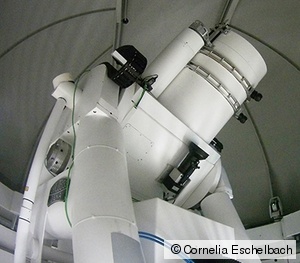
Local ties are crucial components within the combination process and affect the global products. In order to obtain a reliable reference frame, local ties must be known with sub-millimetre accuracy. To ensure the stability of the reference points and to reduce the downtime caused by local site measurements, the agenda VLBI2010 and the Global Geodetic Observing System (GGOS) call for an almost automated and continues reference point determination during the regular station process. Especially the determination of reference points of swivel mounted telescopes used for VLBI and SLR is a challenging metrological task. These reference points can neither be materialized nor measured directly by means of optical or tactile measurement systems, and novel indirect approaches are required.
Results and objectives
The Laboratory for Industrial Metrology is a full member of the joint IERS/IAG Working Group on Site Survey and Co-Location and participates in investigations on in-situ reference point determination of VLBI radio telescopes and SLR laser telescopes. For that purpose, innovated mathematical models for reference point determination are developed and measurement campaigns are carried out. The Laboratory for Industrial Metrology collaborates with several multi-technique stations and GGOS core sites, for instance, the Geodetic Observatory Wettzell (Germany) and the Onsala Space Observatory (Sweden).
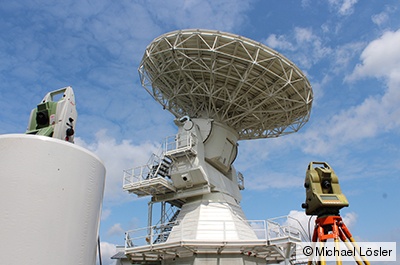
To meet the requirements on an automated reference point determination aimed by GGOS, the Laboratory for Industrial Metrology developed the modular monitoring system HEIMDALL (High-End Interface for Monitoring and spatial Data Analysis using L2-Norm). The HEIMDALL system is developed in the platform-independent programming language Java, and controls external measurement sensors such as total stations, meteorological station or inclinometers via the serial interface. An embedded relational database system is used for data management and administration. For data analysing the in-house network adjustment software package JAG3D is integrated as well as an analysis toolbox for IVS or ILRS reference point determination is implemented. A Kalman filter is applied in the framework of automated and continuous reference point determination. The developed prototype HEIMDALL is, therefore, suitable to fulfill the requirements aimed by GGOS. HEIMDALL is used at Geodetic Observatory Wettzell for regular reference point determinations of the TWIN radio telescopes since 2013.
Guillory, J., Truong, D., Wallerand, J.-P., Lösler, M., Eschelbach, C., Mähler, S., Klügel, T.: Determination of the reference point of a radio telescope using a multilateration-based coordinate measurement prototype. Precision Engineering, 83, pp. 69-81, 2023. DOI: 10.1016/j.precisioneng.2023.05.007
Lösler, M., Eschelbach, C., Mähler, S., Guillory, J., Truong, D., Wallerand, J.-P.: Operator-Software Impact in Local Tie Networks: Case study at Geodetic Observatory Wettzell. Applied Geomatics, 15, pp. 77-95, 2023. DOI: 10.1007/s12518-022-00477-5
Lösler, M., Eschelbach, C., Klügel, T.: Close Range Photogrammetry for High-Precision Reference Point Determination: A Proof of Concept at Satellite Observing System Wettzell. In: Freymueller, J. T., Sánchez, L. (eds.): Geodesy for a Sustainable Earth, Scientific Assembly of the International Association of Geodesy (IAG), Vol. 154, Springer, Berlin, pp. 57-65, 2022. DOI: 10.1007/1345_2022_141
Lösler, M., Eschelbach, C., Klügel, T., Riepl, S.: ILRS Reference Point Determination using Close Range Photogrammetry. Applied Sciences, 11(6), 2785, 2021. DOI: 10.3390/app11062785
Lösler, M., Eschelbach, C., Riepl, S., Schüler, T.: A Modified Approach for Process-Integrated Reference Point Determination. In: Haas, R., García-Espada, S., Lopez Fernández, J. A.: Proceedings of the 24th European VLBI for Geodesy and Astrometry (EVGA) Working Meeting, 17-19 March 2019, Las Palmas de Gran Canaria, Spain, pp. 172-176, 2019. ISBN: 978-84-416-5634-5
Lösler, M., Eschelbach, C., Riepl, S., Schüler, T.: Zur Bestimmung des ILRS-Referenzpunktes am Satellite Observing System Wettzell. In: Luhmann, T., Schumacher, C. (eds.): Photogrammetrie - Laserscanning - Optische 3D-Messtechnik: Beiträge der 18. Oldenburger 3D-Tage 2019, Wichmann, pp. 162-175, 2019. ISBN: 978-3-87907-660-4
Lösler, M., Eschelbach, C., Riepl, S.: A modified approach for automated reference point determination of SLR and VLBI telescopes. tm - Technical Measurement, 85(10), pp. 616-626, 2018, DOI: 10.1515/teme-2018-0053
Mähler, S., Klügel, T., Lösler, M., Schüler, T.: Permanentes Referenzpunkt-Monitoring der Radioteleskope am Geodätischen Observatorium Wettzell. avn - Zeitschrift für alle Bereiche der Geodäsie und Geoinformation, 125(7), pp. 210-219, 2018.
Lösler, M., Haas, R., Eschelbach, C.: Terrestrial monitoring of a radio telescope reference point using comprehensive uncertainty budgeting - Investigations during CONT14 at the Onsala Space Observatory. Journal of Geodesy, 90(5), pp. 467-486, 2016. DOI: 10.1007/s00190-016-0887-8
Lösler, M., Haas, R., Eschelbach, C.: Automated and continual determination of radio telescope reference points with sub-mm accuracy: results from a campaign at the Onsala Space Observatory. Journal of Geodesy, 87(8), pp. 791-804, 2013. DOI: 10.1007/s00190-013-0647-y
Lösler, M.: New Mathematical Model for Reference Point Determination of an Azimuth-Elevation Type Radio Telescope. Journal of Surveying Engineering, 135(4), pp. 131-135, 2009. DOI: 10.1061/(ASCE)SU.1943-5428.0000010
Lösler, M.: Reference point determination with a new mathematical model at the 20 m VLBI radio telescope in Wettzell. Journal of Applied Geodesy, 2(4), pp. 233-238, 2008, DOI: 10.1515/JAG.2008.026
Haas, R., Eschelbach, C.: The 2002 Local Tie Survey at the Onsala Space Observatory. Proceedings of the IERS Workshop on site co-location. Matera, Italy, 23 - 24 October 2003. In: Richter, B., Schwegmann, W., Dick, W.R. (eds.): IERS Technical Note, 33, Frankfurt am Main, Verlag des Bundesamts für Kartographie und Geodäsie, pp. 55-63, 2005.
Eschelbach, C., Haas, R.: The IVS-Reference Point at Onsala - High End Solution for a Real 3D-Determination. In: Schwegmann, W., Thorandt, V. (eds.): Proceedings of the 16th Working Meeting on European VLBI for Geodesy and Astrometry, May 9-10, 2003, Leipzig, Germany, Federal Agency for Cartography and Geodesy, Leipzig/Frankfurt am Main, pp. 109-118, 2003.
Prof. Dr.-Ing.
Cornelia Eschelbach
Phone: +49 (0) 69 1533-2356
cornelia.eschelbach(at)fra-uas.de
Dr.-Ing.
Michael Lösler
Phone: +49 (0) 69 1533-2784
michael.loesler(at)fra-uas.de
Address
Transfer centre
Steinbeis Transfer Centre Applied Geodesy
https://applied-geodesy.org
Member of SCGD
Member of the Society for Calibration of Geodetic Devices e.V. (SCGD)

